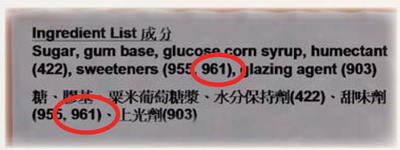
Food Safety Focus (45th Issue, April 2010) – Food Safety Platform
Neotame – A Powerful and Safe Sweetener
Reported by Ms. Janny MA and Ms. Melva CHEN, Scientific Officers,
Risk Assessment Section, Centre for Food Safety
In the past issue, we introduced to you some sugar substitutes. If you think they are not sweet enough, there is great news for you! Neotame, a powerful sweetener, about 7,000 – 13,000 times sweeter than table sugar, may set foot in Hong Kong soon! Compare with other sweeteners available in the market that are about 30 - 2,000 times sweeter than table sugar, neotame is the most potent ever.
What Makes a Substance Taste Sweet?
Sweet is one of the five basic tastes and is regarded as a pleasurable experience. The sweetness receptors in our taste buds enable us to perceive sweet taste. A substance that tastes sweet should have certain specific structures that interact with the sweetness receptors. In nature, carbohydrates, certain amino acids (the building block of protein), glycosides (natural constituents in some plants) taste sweet. Like naturally sweet substances, artificial sweeteners have specific structures that make them taste sweet.
Discovery of Neotame
The old artificial sweeteners such as saccharin and aspartame were discovered accidentally many years ago. On the other hand, the relatively newer sweeteners were often discovered only after countless trials based on our knowledge on chemistry. Following the success of aspartame in the market, there were calls for developing a novel sweetener possessing additional qualities, i.e. higher heat stability, less restrictions on use, higher sweetness potency (less amount to achieve the same sweetness at a lower cost). As such, thousands of compounds were being synthesised based on the simple structure of aspartame. Among these compounds, neotame came up with the desirable qualities.
Portfolio of Neotame
- Name (INS number): Neotame (961)
- Technological functions: Sweetener and flavour enhancer
- Sweetness intensity: ~7,000 – 13,000 times sweeter than table sugar
- Energy value: 0 kcal
- Applications: Preserved fruits, carbonated drinks, baked goods and confectioneries.

Food label showing a list of ingredients with neotame
Safety of Neotame
Sweeteners could be discovered by chance but health authorities will never take a chance when it is about public health. Neotame has been thoroughly assessed and determined safe by international and national authorities. It is neither cancer-causing nor associated with any adverse health effects. Even a total replacement of sugar in the diet with neotame would not result in its "acceptable daily intake" (ADI) being exceeded. ADI is the amount of a substance that is considered to be safe to eat each day during your lifetime. Despite structural similarity of neotame to aspartame, the potential release of phenylalanine from neotame is limited. Therefore, phenylketonuria (PKU) patients can enjoy neotame as well.

Safety of neotame and some common sweeteners
The Sweeter the Better?
As neotame is more potent than currently permitted sweeteners, you may wonder why don't all food products with artificial sweeteners use neotame instead. Well, sweetness intensity is only one of the taste attributes of sweeteners. Compare to sugar, neotame has a delayed sweetness and a slight lingering sweet aftertaste which is not preferred by some people. Until now, no single sweetener can copy the taste profile of sugar exactly. However, a blend of different artificial or natural sweeteners may taste very close to sugar when it is used in certain foods or beverages.
Regulation of Neotame
Codex has permitted the use of neotame as sweetener in various foods. To date, neotame is a permitted sweetener in more than 60 countries/areas such as Mainland China, Australia, New Zealand, the U.S., Canada as well as the European Union where neotame has recently been approved.
Local Situation
As part of the Government's ongoing efforts to keep the local food legislation abreast of the international and scientific developments, neotame as well as another sweetener – steviol glycosides will soon be added to our local regulation as permitted sweeteners. It is therefore not long before we can enjoy this powerful and safe sweetener.
In the coming issue, we are going to savour another sugar substitute - steviol glycosides.


